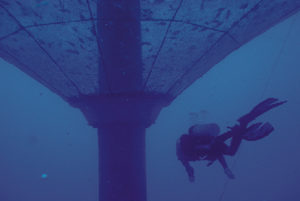
Temperature fluctuations affect biofilter performance in preliminary study
In a recent study, the authors set up a series of temperature-controlled tanks to determine the effects of temperature variation on biofilter performance.
Lake Kariba, on the Zambia-Zimbabwe border, has no industry, few people, high-quality freshwater and an average year-round temperature of 27 degrees-C, all features that can support aquaculture.

In a recent study, the authors set up a series of temperature-controlled tanks to determine the effects of temperature variation on biofilter performance.

Todays' shrimp farm technologies include biosecurity protocols, stocking densities according to pond design and aeration levels, and best practices for pond preparation and feed and water management.

Pond aquaculture in China is trending further from traditional carp polyculture toward monoculture of higher-value fish species.

Limit pond soil analyses to soil particle size for use in pond construction decisions, initial analysis of total sulfur, occasional analyses of total nitrogen, and routine analyses of pH and soil organic carbon.

The direct energy input values for aquaculture include energy used in constructing facilities, producing seedstock and feed, powering mechanical aerators, applying feed and harvesting and processing culture animals.

Membrane biological reactor technology is a scalable wastewater treatment system that reclaims water discharged from RAS solids-collection devices.

Carbon dioxide is both a nutrient and a waste product in aquaculture. Some pond managers feel that application of organic matter to provide additional carbon dioxide can reduce pH and control blue-green algae.

For aquaculture managers, it is important to control carbon type and carbon-nitrogen ratio by feed formulation, solids removal or addition of organic carbon.

As stocking density increases in aquaculture systems, supplemental oxygen becomes necessary. Oxygen generation is becoming a popular option.

Iron supplementation of pond fertilizers can improve their effectiveness in promoting phytoplankton growth. Ferrous iron in bottom sediment precipitates hydrogen sulfide gas produced by microbial activity.

Genetic improvement breeding programs for carp in a number of Asian countries have delivered genetically fast-growing strains to farmers and producers.

Improved feeds and feeding practices increase the proportion of nitrogen recovered in fish and shrimp and lessen the amount of ammonia excreted by the culture animals.

Using the buoyancy of the entrained air bubbles to lift the water, airlifts are more energy-efficient and provide more aeration, carbon dioxide removal and foam fractionation for dissolved solids removal than centrifugal pump systems.

Despite the impacts of the December 2004 tsunami, aquaculture in Aceh, Indonesia, is recovering with support from Indonesian and international agencies.

In a comparison of tank culture and net pen farming of almaco jack, the offshore operations were about twice as efficient per kilogram of product in terms of energy use and carbon inputs.